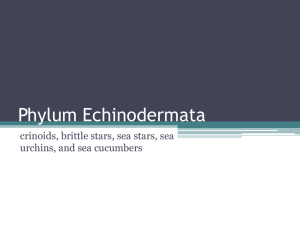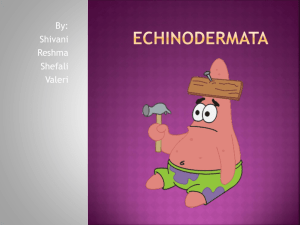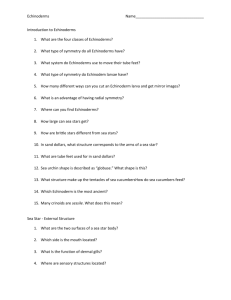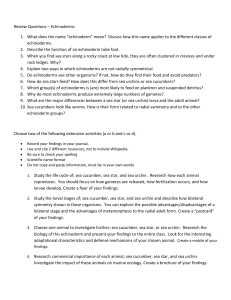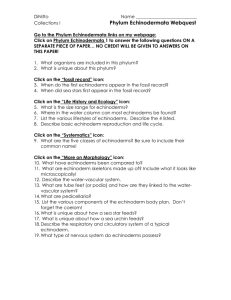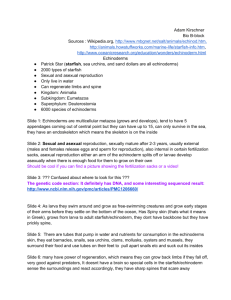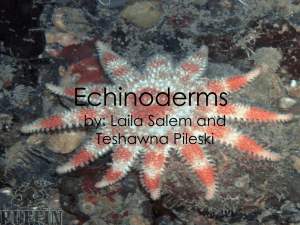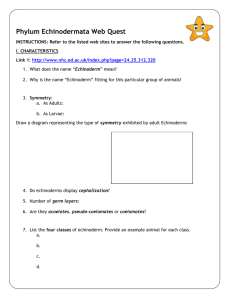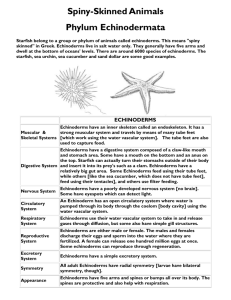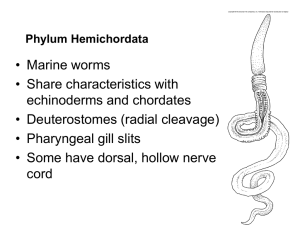Echinoderms
advertisement
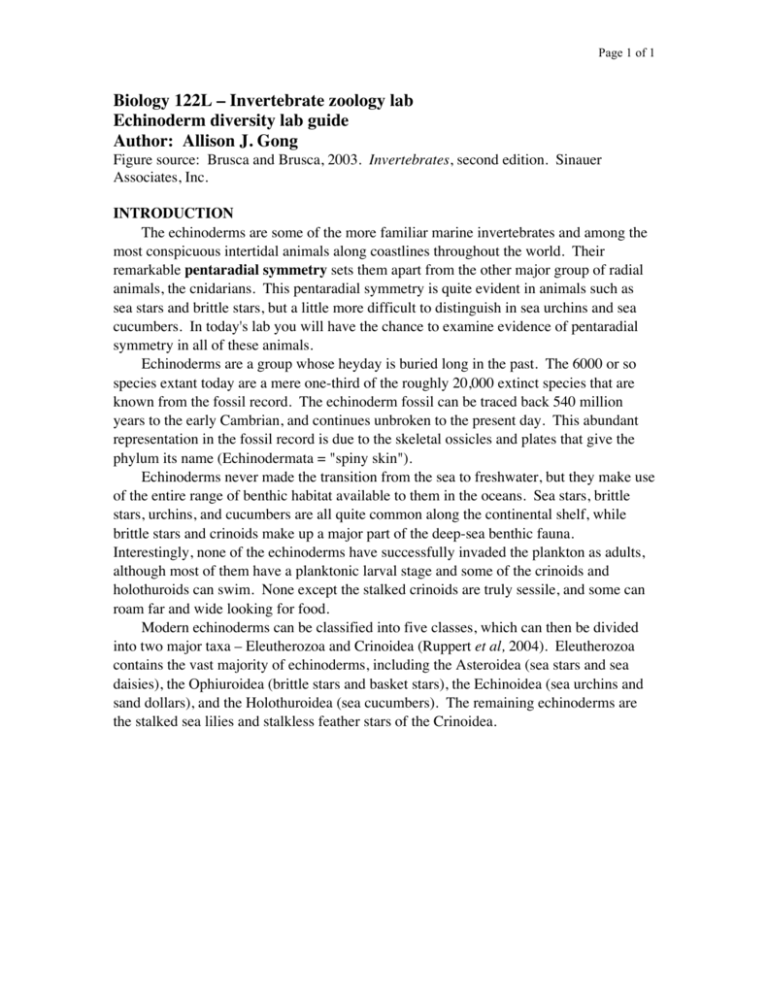
Page 1 of 1 Biology 122L – Invertebrate zoology lab Echinoderm diversity lab guide Author: Allison J. Gong Figure source: Brusca and Brusca, 2003. Invertebrates, second edition. Sinauer Associates, Inc. INTRODUCTION The echinoderms are some of the more familiar marine invertebrates and among the most conspicuous intertidal animals along coastlines throughout the world. Their remarkable pentaradial symmetry sets them apart from the other major group of radial animals, the cnidarians. This pentaradial symmetry is quite evident in animals such as sea stars and brittle stars, but a little more difficult to distinguish in sea urchins and sea cucumbers. In today's lab you will have the chance to examine evidence of pentaradial symmetry in all of these animals. Echinoderms are a group whose heyday is buried long in the past. The 6000 or so species extant today are a mere one-third of the roughly 20,000 extinct species that are known from the fossil record. The echinoderm fossil can be traced back 540 million years to the early Cambrian, and continues unbroken to the present day. This abundant representation in the fossil record is due to the skeletal ossicles and plates that give the phylum its name (Echinodermata = "spiny skin"). Echinoderms never made the transition from the sea to freshwater, but they make use of the entire range of benthic habitat available to them in the oceans. Sea stars, brittle stars, urchins, and cucumbers are all quite common along the continental shelf, while brittle stars and crinoids make up a major part of the deep-sea benthic fauna. Interestingly, none of the echinoderms have successfully invaded the plankton as adults, although most of them have a planktonic larval stage and some of the crinoids and holothuroids can swim. None except the stalked crinoids are truly sessile, and some can roam far and wide looking for food. Modern echinoderms can be classified into five classes, which can then be divided into two major taxa – Eleutherozoa and Crinoidea (Ruppert et al, 2004). Eleutherozoa contains the vast majority of echinoderms, including the Asteroidea (sea stars and sea daisies), the Ophiuroidea (brittle stars and basket stars), the Echinoidea (sea urchins and sand dollars), and the Holothuroidea (sea cucumbers). The remaining echinoderms are the stalked sea lilies and stalkless feather stars of the Crinoidea. Page 2 of 2 Page 3 of 3 Page 4 of 4 WATER VASCULAR SYSTEM One of the most fascinating echinoderm features is the water vascular system – it is truly one of Nature's greatest engineering accomplishments. It consists of a complex series of fluid-filled canals and is visible externally as five groups of tube feet arranged in ambulacral areas. The ancestral function of the water vascular system is food gathering, although groups considered more derived also use it for locomotion. By examining the location of the ambulacral areas and their positions relative to the mouth, you should be able to infer the functions of the water vascular system in a given echinoderm. For example, an ambulacral area that is in contact with a surface might be used for locomotion, although this is not always the case. While observing living echinoderms in today's lab, pay close attention to the ambulacral areas that you see and try to discern how the animal uses them. Note, also, that while tube feet are the external and visible parts of the water vascular system, not all echinoderm tube feet have suckers; this may make them difficult to identify at first glance. How do these observed and inferred functions of the water vascular system vary between echinoderm classes? How do they vary among animals within a class? Questions like these should help you learn to think comparatively as you observe the animals. Page 5 of 5 A diagram of the water vascular system in representative echinoderms may also be useful. Page 6 of 6 As a little self-quiz, can you identify the class to which each of the echinoderms in this diagram belongs? Use your lecture notes to help you. Caveat: animals D, E, and K were not covered in lecture. Page 7 of 7 LARVAL DEVELOPMENT Although echinoderms have pentaradial symmetry as adults, many of them begin life as larvae with bilateral symmetry. You have been observing the larval development of an echinoid, the sea urchin Strongylocentrotus purpuratus, and should be pretty familiar with the echinopluteus larval form. Ophiuroids (brittle stars) have a similar larval form, the ophiopluteus. Asteroids have two planktotrophic larval forms. The first is a lobe-y bipinnaria that goes on to develop long arms and thus is called a brachiolaria. Metamorphosis in these groups (Asteroidea, Ophiuroidea, and Echinoidea) is a very dramatic event: the body of the competent larva attaches to a surface and begins to disintegrate, with some of the larval parts being "recycled" into the new juvenile body while others are discarded. Holothurians (sea cucumbers) have two larval stages, a planktotrophic auricularia that closely resembles the asteroid bipinnaria and a lecithotrophic doliolaria. Metamorphosis in these animals is a more gradual affair than in the echinoderms discussed above. The doliolaria gradually elongates into a pentacula and settles out of the plankton to take up the benthic lifestyle of a sea cucumber.
